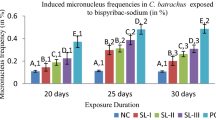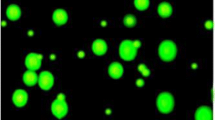Abstract
Since generative tissues are a link between the generations, the detection of genetic damage in testis and ovary of fish is conductive to elucidating the relationship between genotoxicity and impairment of reproduction. In the current study, exposure of zebrafish to methyl methanesulfonate over two weeks caused concentration dependent genotoxic effects in gonads, liver and gills using the alkaline comet assay. Likewise, the micronucleus frequency was elevated in all of these organs. Thus, the comet assay and the micronucleus test proved appropriate for the detection of genotoxicity in primary male and female gonad cells and histological sections of the gonads from zebrafish, respectively.


Similar content being viewed by others
References
Al-Sabti K, Metcalfe CD (1995) Fish micronuclei for assessing genotoxicity in water. Mutat Res 343(2–3):121–135
Anderson SL, Wild GC (1994) Linking genotoxic responses and reproductive success in ecotoxicology. Environ Health Perspect 102(Suppl. 12):9–12
Bätscher R, Studer C, Fent K (1999) Stoffe mit endokriner Wirkung in der Umwelt. Schriftenreihe Umwelt Nr. 308. Bern, Switzerland
Betti C, Barale R, Pool-Zobel BL (1993) Comparative studies on cytotoxic and genotoxic effects of two organic mercury compounds in lymphocytes and gastric mucosa cells of Sprague-Dawley rats. Environ Mol Mutagen 22(3):172–180
Bony S, Gaillard I, Devaux A (2010) Genotoxicity assessment of two vineyard pesticides in zebrafish. Int J Environ Anal Chem 90(3–6):421–428
Böttcher M, Grund S, Keiter S, Kosmehl T, Reifferscheid G, Seitz N, Suares Rocha P, Hollert H, Braunbeck T (2010) Comparison of in vitro and in situ genotoxicity in the Danube River by means of the comet assay and the micronucleus test. Mutat Res 700:11–17
Braunbeck T, Storch V (1992) Senescence of hepatocytes isolated from rainbow trout (Oncorhynchus mykiss) in primary culture—an ultrastructural study. Protoplasma 170(3–4):138–159
Burkhardt-Holm P, Peter A, Segner H (2002) Decline of fish catch in Switzerland. Aquat Sci 64:36–54
Çavaş T, Ergene-Gözükara S (2003) Micronuclei, nuclear lesions and interphase silver-stained nucleolar organizer regions (AgNORs) as cyto-genotoxicity indicators in Oreochromis niloticus exposed to textile mill effluent. Mutat Res 538(1–2):81–91
Çavaş T, Garanko NN, Arkhipchuk VV (2005) Induction of micronuclei and binuclei in blood, gill and liver cells of fishes subchronically exposed to cadmium chloride and copper sulphate. Food Chem Tox 43:569–574
Clements C, Ralph S, Petras M (1997) Genotoxicity of select herbicides in Rana catesbeiana tadpoles using the alkaline single-cell gel DNA electrophoresis (comet) assay. Environ Mol Mutagen 29:277–288
Cook PM, Robbins JA, Endicott DD, Lodge KB, Guiney PD, Walker MK, Zabel EW, Peterson RE (2003) Effects of aryl hydrocarbon receptor-mediated early life stage toxicity on lake trout populations in Lake Ontario during the 20th century. Environ Sci Technol 37(17):3864–3877
De Lafontaine Y, Gilbert NL, Dumouchel F, Brochu C, Moore S, Pelletier É, Dumont P, Branchaud A (2002) Is chemical contamination responsible for the decline of the copper redhorse (Moxostoma hubbsi), an endangered fish species, in Canada? Sci Total Environ 298(1–3):25–44
Della Torre C, Petochi T, Corsi I, Dinardo MM, Baroni D, Alcaro L, Focardi S, Tursi A, Marino G, Frigeri A, Amato E (2010) DNA damage, severe organ lesions and high muscle levels of As and Hg in two benthic fish species from a chemical warfare agent dumping site in the Mediterranean Sea. Sci Total Environ 408(9):2136–2145
Devaux A, Fiat L, Gillet C, Bony S (2011) Reproduction impairment following paternal genotoxin exposure in brown trout (Salmo trutta) and Arctic charr (Salvelinus alpinus). Aquat Toxicol 101(2):405–411
Deventer K (1996) Detection of genotoxic effects on cells of liver and gills of B. rerio by means of single cell gel electrophoresis. Bull Environ Contam Toxicol 56(6):911–918
Diekmann M, Hultsch V, Nagel R (2004a) On the relevance of genotoxicity for fish populations I: effects of a model genotoxicant on zebrafish (Danio rerio) in a complete life-cycle test. Aquat Toxicol 68(1):13–26
Diekmann M, Waldmann P, Schnurstein A, Grummt T, Braunbeck T, Nagel R (2004b) On the relevance of genotoxicity for fish populations II: genotoxic effects in zebrafish (Danio rerio) exposed to 4-nitroquinoline-1-oxide in a complete life-cycle test. Aquat Toxicol 68(1):27–37
Ellis EA (2006) Corrected formulation for Spurr low viscosity embedding medium using the replacement epoxide ERL 4221. Microsc Mircoanal 12:288–289
Fairbairn DW, Olive PL, O’Neill KL (1995) The comet assay: a comprehensive review. Mutat Res 339:37–59
Faßbender C, Braunbeck T (2013) Reproductive and genotoxic effects in zebrafish after chronic exposure to methyl methanesulfonate in a multigeneration study. Ecotoxicology. doi:10.1007/s10646-013-1057-x
Fenech M (2000) The in vitro micronucleus technique. Mutat Res 455:81–95
Gómez-Bombarelli R, González-Pérez M, Arenas-Valgañón J, Céspedes-Camacho IF, Calle E, Casado J (2011) DNA-damaging disinfection byproducts: alkylation mechanism of mutagenic mucohalic acids. Environ Sci Technol 45:9009–9016
Guilherme S, Gaivão I, Santos MA, Pacheco M (2012) DNA damage in fish (Anguilla anguilla) exposed to a glyphosate-based herbicide—Elucidation of organ-specificity and the role of oxidative stress. Mutat Res 743(1–2):1–9
Helma C, Knasmüller S, Schulte-Hermann R (1994) Die Belastung von Wässern mit gentoxischen Substanzen. Umweltwiss Schadst Forsch 6(5):277–288
Jha AN (2008) Ecotoxicological applications and significance of the comet assay. Mutagenesis 23(3):207–221
Keiter S, Rastall A, Kosmehl T, Wurm K, Erdinger L, Braunbeck T, Hollert H (2006) Ecotoxicological assessment of sediment, suspended matter and water samples in the upper Danube River. A pilot study in search for the causes for the decline of fish catches. Environ Sci Pollut Res Int 13(5):308–319
Kligerman AD (1979) Induction of sister chromatid exchanges in the central mudminnow following in vivo exposure to mutagenic agents. Mutat Res 64(3):205–217
Kosmehl T, Krebs F, Manz W, Erdinger L, Braunbeck T, Hollert H (2004) Comparative genotoxicity testing of Rhine River sediment extracts using the comet assay with permanent fish cell lines (RTG-2 and RTL-W1) and the Ames test. J Soils Sediments 4(1):84–94
Lacaze E, Geffard O, Bony S, Devaux A (2010) Genotoxicity assessment in the amphipod Gammarus fossarum by use of the alkaline comet assay. Mutat Res 700:32–38
Lewis C, Galloway T (2009) Reproductive consequences of paternal genotoxin exposure in marine invertebrates. Environ Sci Technol 43(3):928–933
Lundin C, North M, Erixon K, Walters K, Jenssen D, Goldman ASH, Helleday T (2005) Methyl methanesulfonate (MMS) produces heat-labile DNA damage but no detectable in vivo DNA double-strand breaks. Nucleic Acids Res 33(12):3799–3811
McKelvey-Martin VJ, Green MHJ, Schmezer P, Pool-Zobel BL, De Méo MP, Collins A (1993) The single cell gel electrophoresis assay (comet assay): a European review. Mutat Res 288:47–63
Odeigah PGC, Osanyipeju AO (1995) Genotoxic effects of two industrial effluents and ethyl methane sulfonate in Clarias lazera. Food Chem Tox 33(6):501–505
Santos TG, Martinez CBR (2012) Atrazine promotes biochemical changes and DNA damage in a Neotropical fish species. Chemosphere 89(9):1118–1125
Schnurstein A, Braunbeck T (2001) Tail moment versus tail length—application of an in vitro version of the comet assay in biomonitoring for genotoxicity in native surface waters using primary hepatocytes and gill cells from zebrafish (Danio rerio). Ecotox Environ Saf 49(2):187–196
Singh NP, McCoy MT, Tice RR, Schneider EL (1988) A simple technique for quantitation of low levels of DNA damage in individual cells. Exp Cell Res 175:184–191
Spurr AR (1969) A low viscosity embedding medium for electron microscopy. J Ultrastr Res 26:94–125
Strauss GHS (1991) Non-random cell killing in cryopreservation: implication for performance of the battery of leucocyte tests (BLT). I. Toxic and immunotoxic effects. Mutat Res 252:1–15
Takashima F, Hibiya T (1995) An atlas of fish histology—normal and pathological features, 2nd edn. Gustav Fischer Verlag, New York
Uren-Webster TM, Lewis C, Filby AL, Paull GC, Santos EM (2010) Mechanisms of toxicity of di(2-ethylhexyl) phthalate on the reproductive health of male zebrafish. Aquat Toxicol 99(3):360–369
Weigert K (1904) Eine kleine Verbesserung der Hämatoxylin-van Gieson-Methode. Z f wiss Mikr u f mikr Techn 21:1–5
Acknowledgments
The first author wishes to express his gratitude to Prof. Dr. Henner Hollert for co-supervision and to the Deutsche Bundesstiftung Umwelt (DBU) for a PhD scholarship.
Author information
Authors and Affiliations
Corresponding author
Rights and permissions
About this article
Cite this article
Faßbender, C., Braunbeck, T. Assessment of Genotoxicity in Gonads, Liver and Gills of Zebrafish (Danio rerio) by Use of the Comet Assay and Micronucleus Test after In Vivo Exposure to Methyl Methanesulfonate. Bull Environ Contam Toxicol 91, 89–95 (2013). https://doi.org/10.1007/s00128-013-1007-6
Received:
Accepted:
Published:
Issue Date:
DOI: https://doi.org/10.1007/s00128-013-1007-6




